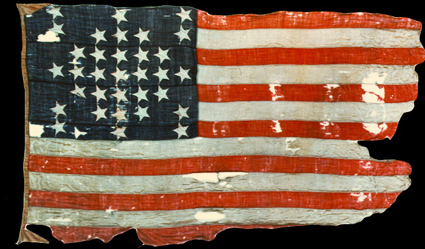Eating Flags December 22, 2011
Author: Beach Combing | in : Contemporary, Modern , trackback
In Beachcombing compendious filing cabinets there is a surprisingly thin folder on flags. ‘Surprising’ as flags, as highly charged symbols, encourage moving and peculiar behaviour. One of the most notable films of the last years is, after all, the Flags of Our Fathers (2006) telling the story of that photograph and Old Glory on Iwo Jima. A recent bit of flag japes was the Canadian raid on Greenland rock in 2005 that ended with the Danish flag being torn down and mailed to the Danish ambassador in Ottawa: the Canadians are always so respectful. There was that embarrassing go-to when Bill Clinton misunderstood the Romanian flag given to him as a gift (with the Communist centre cut out) as a poncho! Memorable too was Chris Patton weeping over the Union Jack as Hong Kong was handed over to the Chinese in 1997. The most vivid description of the military coup in Chile in 1973 known to Beach is, meanwhile, the description of a pilot fighting for General Pinochet flying a strafing run at the Presidential palace and finding, to his horror, the Chilean flag in his cross-hairs. And always remember that burning a bit of fabric that happens to have red, white and blue can get you fined up to 7,500 euros in France; while burning the Turkish flag (in Turkey) will get you landed in prison for three years – Kurds beware!
The best flag stories though involves the standards of losing armies: echos of the lost eagles of the Romans. Major Robert Anderson’s shot up flag from Fort Sumter in 1861 became one of the most potent proofs of northern determination in the first days of the Civil War. It is pictured above. The same flag was raised there at the fort again in 1865 by the then General Robert Anderson and the image was borrowed after Pearl Harbour.
But at least Anderson was, in the end, on the winning side. Imagine you have fought under Lee for four years and then in 1865 comes the news that the army is to surrender and that the flag is to be given to the enemy. What do you do in that situation? That ‘bit of fabric’ (as Beach called it above), often riddled with bullets, had held men in line and prevented routs, in desperate moments it was all that stood between defeat and victory, the greatest sacrifices had been made to keep it flying:
‘Our color bearer knocked down a Yankee with his flag staff, and was shot to death at once. One of the color guard took the flag, and he also was killed; another, Roswell S. Lindsay of F Company, bayoneted a Yankee, and was immediately riddled with balls, three going through him. Four color bearers were killed with the colors in their hands, the fifth man flung the riddled flag to the breeze, and went through the terrible battle unhurt.’
Are you really going to abandon the Virginia battle flag (the flag you had sworn never to fail) or will you hand it over to a colonel from New York or Rhode Island and allow it to become a souvenir in the mansion of a northern governor?
Of course, men in situations like this would do anything rather than let the flag fall into the hands of their foes. George Barbee of the Forty Fourth North Carolina hurled his flag into the river Appomattox, others burnt theirs. Andrew Payne cut out the centre of his Confederate flag and sewed it into the lining of his coat to get it home: as the poncho stories above suggested there is a post to be written on flags with their hearts’ cut out of them. There are stories too of Confederate flags being ripped up and divided by veterans determined to share the symbol among themselves rather than give it to the enemy.
The most beautiful story though of a flag in a defeated battalion is that of the Italian units of Napoleon’s Imperial army. When the news came in 1814 that these men were to be absorbed into the (hated) Austrian army they took their flags and burnt them, slopping the ashes into soup that all the men would then consume: the flag and the army became one.
Any other good flag stories: drbeachcombing AT yahoo DOT com
***
30 Dec 2011: Jay writes in about one of the most famous flags of all ‘Your post on surrendering flags makes me wonder about the fate of Hitler’s Blood Flag. This was the most ‘sacred’ symbol of Nazism, being the swastika-blazoned banner that was carried during the failed Beer Hall Putsch in November 1923. It was called the ‘Blood Flag’ because it was stained with the gore of fallen Nazis. Hitler used this flag to consecrate other flags, including the battle standards of the SS. The rather spooky ceremony can be seen in “Triumph of the Will” of him touching it to the banners one by one. Anyway, as far as I know, the flag was not found at the end of the war. I imagine it decorates some bunker in Argentina or secret Neo-Nazi Fortress of Doom in Antarctica.’ Thanks Jay!


